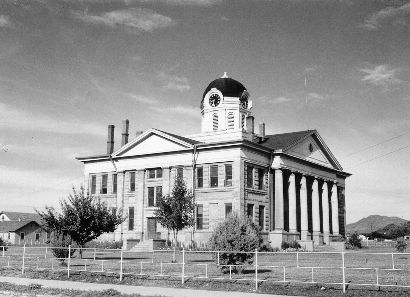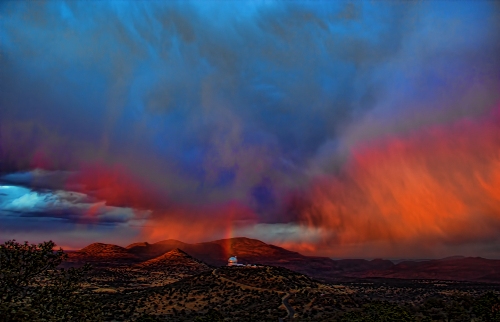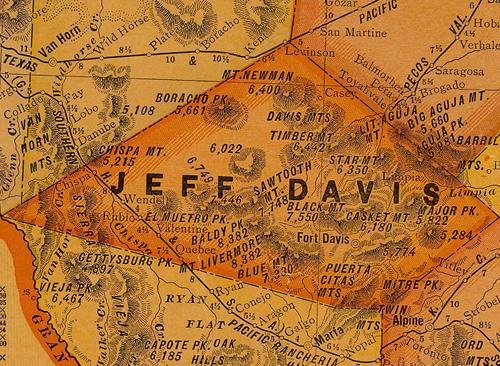Fort Davis, Texas, Jeff Davis County. (original) (raw)
Jeff Davis County Seat, West Texas
30�35'34"N 103�53'31"W (30.592880, -103.891996)
Hwys 17 & 118
38 miles S of Balmorhea at I-10
21 miles NE of Marfa 26 miles NW of Alpine
ZIP code 79734
Area code 432
Population: 1,024 (2020)
1,201 (2010) 1,050 (2000)
 |
Ft. Davis and its Buildings c. 1950 Photo Courtesy TXDoT |
|---|
History in a Pecan Shell
The county, town and fort were all named after Jefferson Davis, although the county had originally been Presidio County. Fort Davis was named prior to Davis' term as President of the Confederate States. As U.S. Secretary of War - Davis signed the order establishing the facility and was thus honored.
Originally the site of the fort was an Indian camp. A stage stop was set up in 1850 for the mail route between San Antonio and El Pasowith a man named Diedrick Dutchoverin charge. The Fort was formed in 1854 to billet the troops needed to patrol and protect the area from Apaches.
During the Civil War, the Confederate Army left Diedrick in charge of the fort, but he and his party were attacked by Apaches.and forced to abandon the place. In 1867, The Ninth U.S. Cavalry reoccupied the fort and the town experienced new growth as an important West Texas crossroads.
Ft. Davis had only 500 people in 1894, but the population remained between 700-1,200 for decades. Various plans to develop Ft. Davis as a tourist destination have failed over the years - not because they were bad ideas - but because of the deaths of the would-be developers. One such plan was instrumental in getting approval of Ft. Davis as a National Historic Site in 1961.
[Fort Davis] is literally a �mile-high�, the environment holds a distinct juxtaposition to the rest of the surrounding west Texas desert. While Marfa, Marathon and Terlingua all radiate an aura of dust and heat, Fort Davis exudes a cooler, even floral animus; even in July a sweater is needed in the evenings. However, even more interesting was the history of the place. The territory�s rich climate has drawn human activity for, well, a helluva long time. The Native American pictograms that adorn the rocks and cave walls throughout the area give evidence of this.
The first American settlers began to drive their cattle into this fecund land in the late nineteenth century, at the end of the American Civil War. By the 1870s the violence that the Native Americans (mainly Mescalero Apache and Comanche tribes) and the new settlers were hurling at each other warranted intervention by the United States government. Military forts were established as protection for the stage lines, the mail routes, the railroads and, of course, those early settlers who chose to try to scrape out a living amongst all of the chaos that permeated the territory. A peculiar lawlessness pervaded this section of the country at this time. If you couple the inherent violence that persisted in the region after the Civil war with the Indian �depredations�, the early residents had to sacrifice personal safety for the quality of the land they had chosen. Clearly, a military presence was needed if any claim to permanency was to be hoped for or even expected.
Fort Davis, the actual fort, not the town, was garrisoned twice; once ante bellum and then again, post bellum. It is the second effort that is the more successful and historical. The famous �Buffalo Soldiers� completed the second occupation of the fort. And, it is the person and family of Colonel B.H. (Benjamin Henry) Grierson, the commander of the Tenth United States Cavalry at Ft. Davis, who exemplify the renowned history of the territory... next page
Fort Davis Landmarks / Attractions:
1939 Photo courtesy TXDoT

Jeff Davis County Jail. Built at the same time as the courthouse (1910.) No historical marker.
Photo Courtesy Terry Jeanson, Dec. 2005
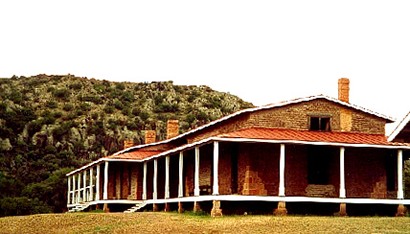
Ft Davis
Photo courtesy Shirley Kirby, 2004
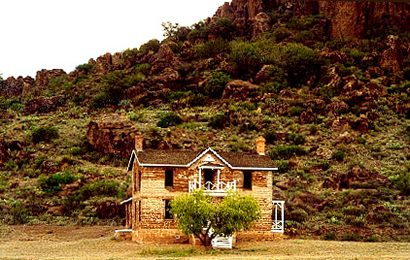
Ft Davis Officers Quarters
Photo courtesy Shirley Kirby, 2004
Fort Davis National Historic Site
Est. in 1854 - deactivated in 1891.
This was the main Fort that garrisoned troops that patrolled the border from El Paso to San Antonio. The post was abandoned during the Civil War and re-occupied by troops of the 9th Cavalry.
Museum. Open 9 to 5 daily except for major holidays.
 |
Overland Trail Museum TE photo, 2000 |
|---|
- Overland Trail Museum
Former home of Nick Mersfelter, Barber, Justice of the Peace and versatile musician. Many historical relics of early life in the area - Davis Mountains State Park
6 miles west of Ft. Davis on Park Road 3 off Hwy 118. 1,800 acres. - Chihuahuan Desert Visitor Center
A must-see for the visiting naturalist.
On Hwy 118, 3.5 miles south of Ft. Davis.
915-364-2499.
McDonald Observatory
View from Fort Davis looking NE toward Mt Locke
during a fast moving storm
Photo courtesy Coyne Gibson, February 12, 2013
- The McDonald Observatory
Nearby, on top of Mount Locke (Altitude 6,800 ft.) - 16 miles NW of Fort Davis. Managed and owned by the University of Texas. At the bottom of the mountain.
Visitor's Center open daily 9 to 5. 1-877-984-7827.
"There is one telescope here that�s owned by 5 universities, but not the whole complex. Everything here is managed and owned by the Univ. of Texas. Also, if anyone wants more information about the new Visitors Center here, they can check our website at
http://McDonaldObservatory.org or call our toll free information line at 1-877-984-7827. Enjoyed your site! Thanks."
- Mark Cash, Public Affairs Specialist, U.T. McDonald Observatory, September 28, 2002
The Chamber of Commerce: 432-426-3015
Website: www.fortdavis.com
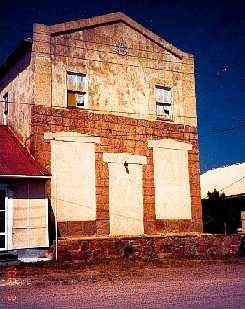 |
Fort Davis Masonic Lodge TE photo |
|---|
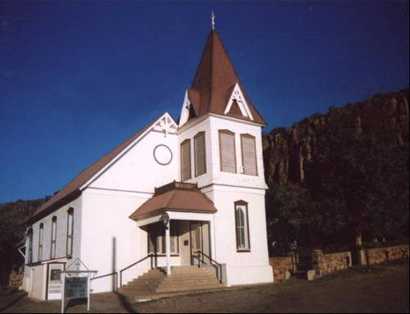
First Presbyterian Church in Fort Davis
Photo courtesy Barclay Gibson, 2005
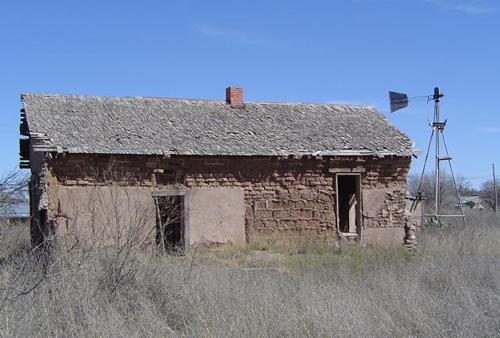
An abandoned homestead near Ft. Davis
Photo Courtesy Patrick Cantrell, June 2006
Fort Davis Chronicles:
- Hoxie's Moxie by Mike Cox ("Texas Tales" column)
Thirty-seven years after the Army abandoned Fort Davis, a celluloid cowboy announced plans to convert the old cavalry post into a motion picture colony and resort.... - Flora�s Tree by Mike Cox ("Texas Tales" column)
The giant pecan, which still stands outside Helen Bentley�s house in Fort Davis, grew from a sapling planted in 1873... - Indian Emily by Mike Cox ("Texas Tales" column)
One of the most romantic stories in the lore of the Old West originated at Fort Davis... In the late 1860s, an Apache female fell wounded in a skirmish between cavalry troops stationed at Fort Davis and her band....
Fort Davis in the 1950s

Photo Courtesy Kat Copeland
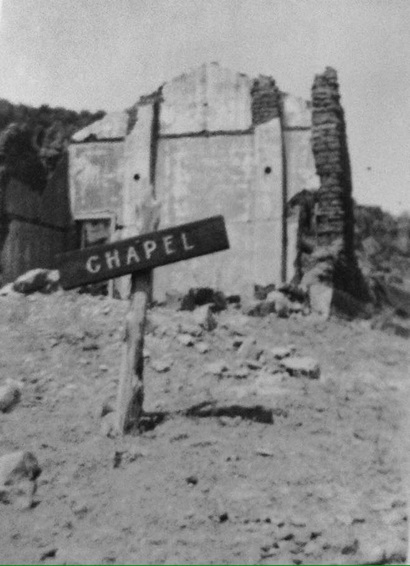
Photo Courtesy Kat Copeland

Fort Davis Forum
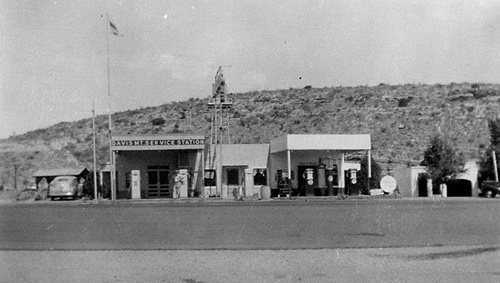
Do you know where this gas station in the Davis Mountains was?
Photo courtesy Nancy McVickar
- Subject: Davis Mountain Station/Davis Mountain Junction
I just ran across the photo posted by Nancy McVickar. I believe that station was located at the Junction of US 80 and US 290 - now I-10 and I-20. That location is noted in the lower right of a very old map from the University of Texas' collection:
I've long been interested in Davis Mountain Station (a/k/a Davis Mountain Junction). It seems to have been not much more than that gas station and was completely obliterated when the I-10/I-20 split was built.
Have you ever run across any other information about it!? - Many thanks, Martin Bartlett, El Paso - Do you know where this gas station in the Davis Mountains was?
My Grandparents owned a gas station at Davis Mt., Texas (see photo). Would you or any of your readers know the address of this station? I doubt it is still standing. The photo which was in my grandmother's photo album belongs to my cousin who was planning a trip out that way in mid-September and doesn't recall the address or the highway. She spent some time with our grandparents there when she was a little girl when they were running the station. Any information would be appreciated. Thank you. - Alysia (Meyers) Hargus, August 26, 2004
- Subject: Naming Jeff Davis County
Just a note to correct a misstatement by one of your correspondents on the Ft. Davis page. C. F. Eckhardt wrote on June 3, 2006, that Texas has the only county in the country named after the Confederate president, Jefferson Davis. This is actually an error. *There is a Jeff Davis County in Georgia (where else?!); the town of Hazelhurst is the county seat (it's in Southeast Georgia).
I ran across Texas Escapes more or less by chance (I was searching for the Texas Cowboy Poetry Gathering website at the time), and I immediately bookmarked your production. It is a wonderful resource for those who are interested in Texas, its people, its geography, and its history. I am not a Texas native, but two of our four daughters are--and they are quite proud of that fact. My wife and I spent three quite enjoyable years in Austin while I earned my Ph.D. in English at the University of Texas ("Hook 'Em, Horns!"). I look back on my days in Texas as among the best three years of my life. (I'm now a retired college English professor.)
Thank your for the effort you have put into making Texas Escapes such a good [magazine]. - Cordially, Rick Thurman, (Dr. William R. Thurman, Jr.),Thomaston, Georgia, August 28, 2007 - Subject: Naming Jeff Davis County
Fort Davis, the military post, was originally named for then-Secretary of War Jefferson Davis, who expanded the army & for the first time started calling Regular Army horse soldiers cavalry. Up to then they'd been dragoons & mounted rifles. After the War Between the States, when the US Army reoccupied Fort Davis, it was announced that the post would no longer be Fort Jefferson Davis, but Fort Edmund J. Davis. E. J. Davis, the reconstruction governor, was probably the single most hated man in Texas at the time. Therefore, when the county was split off from Presidio County, the people voted to name it 'Jeff Davis County,' restoring the name of the original fort. As a result, Texas has the only county in the country named for the Confederate President*--and the only county in the world named for Ireland's patron saint--San Patricio. - C. F. Eckhardt, June 03, 2006 - Turnstiles on Court House Grounds
Around 1993 when I had taken a group to the Big Bend and we stayed at the Prue Ranch, I asked one of the local citizens about the turnstiles on the Jeff Davis Court House grounds. She informed me that they were placed there to keep the burros out. Originally, trade between the US and Mexico was conducted by traders using the burros as pack animals to carry the trade goods. When the burros were replaced by wagons, the traders let the burros run loose. The burros made the court house grounds part of their home. They became such a nuisance that the locals built the fence and the four turnstiles around the court house to keep them out. - John Gibbs, March 25, 2006
 |
Catilyn Bailey Courtesy Mr. and Mrs. Bailey � 1996 Kermit Lancaster |
|---|
Caitlyn Bailey was a pioneer reenactor at the Fort. She and her brother Kyle (not pictured) would remind visitors that there were children out west too. The photo was taken in 1996 by Kermit Lancaster who added that "�.Caitlyn was a wonderful addition to our visit to Fort Davis. My own daughters were 10 and 6 at the time. Caitlyn showed them how to wash clothes "pioneer-style" in a washtub with lye soap and hang them out to dry. It was great fun for the girls to perform that menial chore... once!"
Jeff Davis County 1920s map showing Fort Davis
From Texas state map #10749
Courtesy Texas General Land Office
Texas Escapes, in its purpose to preserve historic, endangered and vanishing Texas, asks that anyone wishing to share their local history, stories, landmarks and recent or vintage photos, please contact us.
